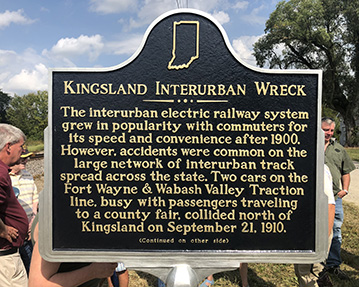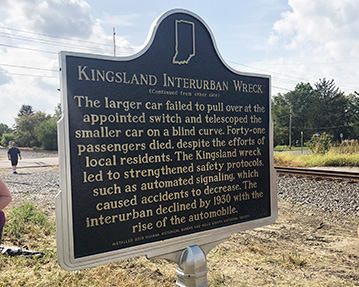Kingsland Interurban Wreck


Location: North side of US 224 and Market St., Kingsland (Wells County), Indiana 46777
Installed 2019 Indiana Historical Bureau and Wells County Historical Society
ID#: 90.2019.1
Text
Side One
The interurban electric railway system grew in popularity with commuters for its speed and convenience after 1900. However, accidents were common on the large network of interurban track spread across the state. Two cars on the Fort Wayne & Wabash Valley Traction line, busy with passengers traveling to a county fair, collided north of Kingsland on September 21, 1910.
Side Two
The larger car failed to pull over at the appointed switch and telescoped the smaller car on a blind curve. Forty-one passengers died, despite the efforts of local residents. The Kingsland wreck led to strengthened safety protocols, such as automated signaling, which caused accidents to decrease. The interurban declined by 1930 with the rise of the automobile.
Annotated Text
Side One
The interurban electric railway system grew in popularity with commuters for its speed and convenience after 1900.[1] However, accidents were common on the large network of interurban track spread across the state.[2] Two cars on the Fort Wayne & Wabash Valley Traction line, busy with passengers traveling to a county fair, collided north of Kingsland on September 21, 1910.[3]
Side Two
The larger car failed to pull over at the appointed switch and telescoped the smaller car on a blind curve.[4] Forty-one passengers died, despite the efforts of local residents.[5] The Kingsland wreck led to strengthened safety protocols, such as automated signaling, which caused accidents to decrease.[6] The interurban declined by 1930 with the rise of the automobile.[7]
[1] Arnold Electric Power Station Co., Electric Railways in Indiana, 1904 [map] in Street Railway Review 14:1 (January 20, 1904): 44-46, accessed GoogleBooks; American Engineering Company, Electric Interurban Map of Indiana, 1905, Indiana State Library Map Collection, accessed http://cdm16066.contentdm.oclc.org/cdm/ref/collection/p15078coll8/id/2940 ; Clifton J. Phillips, Indiana in Transition: The Emergence of an Industrial Commonwealth, 1880-1920 (Indianapolis: Indiana Historical Bureau & Indiana Historical Society, 1968), 251-8; Indiana Public Service Commission,” Interurban Railroads” in Annual Report of the Public Service Commission of Indiana for the Fiscal Year Ending September 30, 1914 to the Governor (Indianapolis: Wm. B. Burford, Contractor for Printing and Binding, 1914), 23-25, accessed GoogleBooks; Christopher Rund, The Indiana Rail Road Company: America’s New Regional Railroad (Bloomington & Indianapolis: Indiana University Press, 2006), 97.
Soon after the turn of the twentieth century, the electric railway system known as the interurban connected many Indiana cities and towns. The interurban became a popular form of transportation with Indiana commuters because of its speed and convenience. According to railroad historian Christopher Rund, “the interurban was perhaps the most advanced, convenient, widely used mode of intercity transportation available to average folks in middle America” before the Good Roads era. In fact, reports of the Railroad Commission and the later Public Service Commission show that during its brief reign, it was more popular than steam tail travel for passengers.
[2] Indiana Railroad Commission, “Electric Roads – Table No. 2” in Fourth Annual Report of the Railroad Commission of Indiana 1909 to the Governor (Indianapolis: Wm. B. Burford, Contractor for State Printing and Binding, 1910), 592-3, Indiana Collection, Indiana State Library; Indiana Railroad Commission, “Electric Roads – Table No. 3” in Fifth Annual Report of the Railroad Commission of Indiana 1910 to the Governor (Indianapolis: Wm. B. Burford, Contractor for Printing and Binding, 1911), 464-5, Indiana Collection, Indiana State Library; Joseph A. McGowan, “What Interurban Railways Do for the Public,” in Proceedings of the American Street and Interurban Railway Association 1910 (New York: Federal Printing Company, 1910), 270-3, accessed GoogleBooks; Indiana Railroad Commission, Second Annual Report of the Railroad Commission of Indiana 1907 to the Governor (Indianapolis: Wm. B. Burford, Contractor for State Printing and Binding, 1907), 372, 375-376, 379-388, Indiana Collection, Indiana State Library; Indiana Railroad Commission, Third Annual Report of the Railroad Commission of Indiana 1908 to the Governor (Indianapolis: Wm. B. Burford, Contractor for State Printing and Binding, 1909 412-413, 425-427, 439-441, Indiana Collection, Indiana State Library; Indiana Railroad Commission, Fourth Annual Report of the Railroad Commission of Indiana 1909 to the Governor (Indianapolis: Wm. B. Burford, Contractor for State Printing and Binding, 1910), 491-492, 503-504, 512-515, 525-527, 535, 538-539, Indiana Collection, Indiana State Library; Indiana Railroad Commission, Fifth Annual Report of the Railroad Commission of Indiana 1910 to the Governor (Indianapolis: Wm. B. Burford, Contractor for Printing and Binding, 1911), 292-294, 302-305, 313-314, 327-28 418-419, 464-5, Indiana Collection, Indiana State Library.
By 1910, Indiana had over 1,400 miles of interurban track in operation. Several secondary sources claim 1,800 miles which seems to stem from a report to American Street and Interurban Railway Association by an official of an Indiana traction company. However, it was the Railroad Commission of Indiana that regulated the interurban companies and lines. Thus, that organization’s official reports to the governor are used here for official numbers of mileage. In 1909, there were 1,529.67 miles of interurban track in operation. In 1910, this decreased to 1,455.81 miles in operation; though there were 1,681.52 miles owned by companies.
Accidents were common on interurban lines. The Indiana Railroad Commission began reporting accident statistics in 1907, with the first full year of statistics available in 1908. From July 1907 to June 1908 there were 45 deaths reported on the Indiana interurban system and from July 1908 to June 1909 there were 52. From July 1910 to June 1911 there were 94 deaths, 41 from the Kingsland wreck. Comparing accidents with mileage on both Indiana interurban lines and steam lines, we can see that in the years immediately preceding the Kingsland wreck, the number of accidents per mile were slightly less for interurban than steam. For example, in 1909, there was approximately one death for every 27.9 miles of interurban track versus one death for every 19.9 miles of steam railroad track.
[3] “Bluffton Is Scene for A Fatal Wreck,” Richmond Palladium, September 21, 1910, 1, Hoosier State Chronicles; “Terrible Loss of Life in Railroad Wrecks on Steam & Trolley Roads,” Lake County Times, September 22, 1910, 8, Hoosier State Chronicles.
[4] Indiana Railroad Commission, Fifth Annual Report of the Railroad Commission of Indiana 1910 to the Governor (Indianapolis: Wm. B. Burford, State Contractor for State Printing and Binding, 1910), 381-2, accessed GoogleBooks; “ . . .Escape for Every Soul: Scarcely a Passenger on Ill-Fated Car Who Did Not Meet Death or Serious Injury,” (Fort Wayne) Weekly Sentinel, September 28, 1910, 14, accessed Newspapers.com; “Terrible Loss of Life in Railroad Wrecks on Steam and Trolley Roads,” Lake County Times, September 22, 1910, 1, Hoosier State Chronicles; “Two Serious Accidents on Indiana Interurban Lines,” Electric Railway Journal 36:14 (October 1, 1910), 493, accessed GoogleBooks; “Serious Wreck on Ft. Wayne & Wabash Valley,” Electric Traction Weekly 6:39 (September 24, 1910): 1064, accessed GoogleBooks; “Traction Report Blames Two Men,” Indianapolis Star, September 24, 1910, 4, accessed Newspapers.com; “The Human Element in Train Operation,” Electric Railway Journal 36:14 (October 1, 1910), 493, accessed GoogleBooks.
The Railroad Commission of Indiana determined that the crew of a large southbound “extra” car No. 303 [extra meaning not on the regular schedule, but instead employed for the overflow of people attending the fair] had failed to pull over at the appointed “siding” or “switch” or “sidetrack” to let the regularly scheduled northbound “local” car No. 233 pass. The northbound car was a small Indiana Union Traction Company streetcar. The larger, heavier car “telescoped” the smaller which was full of passengers, killing forty-one people, most instantly. Investigators for the Fort Wayne & Wabash Valley Traction line and insurance companies agreed with the Commission’s assessment of causation in independent investigations.
[5] “Terrible Loss of Life in Railroad Wrecks on Steam and Trolley Roads,” Lake County Times, September 22, 1910, 1, Hoosier State Chronicles; “Serious Wreck on Ft. Wayne & Wabash Valley,” Electric Traction Weekly 6:39 (September 24, 1910): 1064, accessed GoogleBooks; “The Wreck Horror to First on Scene,” Bluffton Chronicle, September 28, 1910, 1, submitted by applicant, copy in IHB marker file; “Forty-Two Victims of Big Wreck,” Richmond Palladium, September 22, 1910, 1, accessed Hoosier State Chronicles; “Death List Now Reaches Forty-One and Other Fatalities Hourly Expected, Muncie Evening Press, September 22, 1910, 1, accessed Newspapers.com; “Special Grand Jury Called to Probe Wreck Monday,” Fort Wayne Journal-Gazette, September 23, 1910, 1, accessed Newspapers.com; (Fort Wayne) Weekly Sentinel, September 28, 1910, 14; Report of Wells County Coroner Herman Thoma in Bluffton Evening News, October 10, 1910 and Report of Allen County Coroner A.J. Kesler in Bluffton Evening News, October 18, 1910. Both sources are reprinted in Larry W. Owen, The Kingsland Wreck: A Memorial, 3-10, accessed Wells County Public Library; Indiana Railroad Commission, Fifth Annual Report of the Railroad Commission of Indiana 1910 to the Governor (Indianapolis: Wm. B. Burford, State Contractor for State Printing and Binding, 1910), 382, accessed GoogleBooks; “Bluffton Transformed into City of Deepest Mourning,” Muncie Evening Press, September 22, 1910, 1, accessed Newspapers.com.
Residents of local farms and a section crew from another railroad were the first to respond, followed by medical professionals from Bluffton who arrived by car and others from Fort Wayne sent by the traction company on “a special relief car.” Conductor of the local car, A. E. Spiller, possibly prevented a second collision. He pulled himself from the wreck and ran several yards south to plant a red flag to warn the following Indianapolis Limited car of the wreck. Spiller then lost consciousness. According to coroner’s report and the report of the Indiana Railroad Commission to the Governor, the collision killed forty-one people. Many of those killed were from Bluffton, which mourned its dead in touching public ceremonies.
[6] Indiana Railroad Commission, Fifth Annual Report of the Railroad Commission of Indiana 1910 to the Governor (Indianapolis: Wm. B. Burford, State Contractor for State Printing and Binding, 1910), 381-2, accessed GoogleBooks; “Mark New Era for Rail Commission,” Indianapolis Star, March 11, 1911, 10, accessed Newspapers.com.
The Kingsland wreck led the Indiana Railroad Commission to reevaluate safety protocols and employment records. It determined that employees needed more training and disciplinary action for infringement and that automated systems such as block signals could help dispatchers prevent wrecks. The General Assembly passed a Block Signal Act in response to the Commission’s recommendation.
[7] “Great Traction Empire Gives Way as Cars Are Superseded by Busses,” Indianapolis Star, January 19, 1941, 13, accessed Newspapers.com; Pamela J. Bennett and Shirley S. McCord, eds., Progress After Statehood: A Book of Readings (Indianapolis: Indiana Historical Bureau, 1974), 508; Richard S. Simons and Francis H. Parker, Railroads of Indiana (Bloomington & Indianapolis: Indiana University Press, 1997), 41-42l Clifton J. Phillips, Indiana in Transition: The Emergence of an Industrial Commonwealth, 1880-1920 (Indianapolis: Indiana Historical Bureau & Indiana Historical Society, 1968), 251-8.
Financial instability, competition with steam railroads, and the rise of the automobile led to the decline of the interurban. Cars and busses replaced the interurban as ninety percent of commuters chose auto travel by 1930. According to Bennett and McCord, “By 1930, almost 90 percent of all inter-city travel had shifted to the automobile.”
Keywords
Transportation
